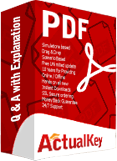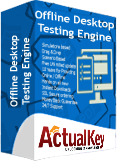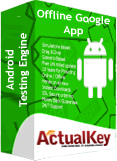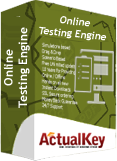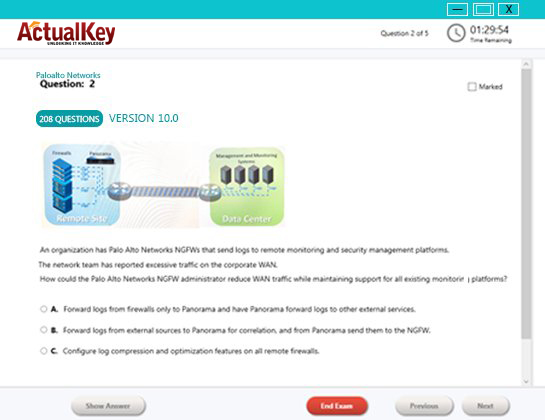Limited Time 30% Discount Offer Use Code - off30
Actualkey Prepration Latest 70-513 : TS: Windows Communication Foundation Development with Microsoft .NET Framework 4 Questions and Answers PDF's, Verified Answers via Experts - Pass Your Exam For Sure and instant Downloads - "Money Back Guarantee".
| Vendor | Microsoft |
| Certification | MCTS |
| Exam Code | 70-513 |
| Title | TS: Windows Communication Foundation Development with Microsoft .NET Framework 4 |
| No Of Questions | 473 |
| Last Updated | September 16,2024 |
| Product Type | Q & A with Explanation |
| Bundel Pack Included | PDF + Offline / Andriod Testing Engine and Simulator |
70-513
TS: Windows Communication Foundation Development with Microsoft .NET Framework 4
About this Exam
This exam is designed to test the candidate's knowledge and skills for developing applications using Windows Communication Foundation and the .NET Framework 4.
Questions that contain code will be presented in either VB or C#. Candidates can select one of these languages when they start the exam.
Audience Profile
The candidate works on a team in a development environment that uses Microsoft Visual Studio 2010 and .NET Framework 4 to build distributed applications. This candidate should have at least one year of experience developing Windows Communication Foundation (WCF)–based applications, including at least six months of experience with .NET Framework 4. The candidate should also be able to demonstrate the following:
A solid understanding of WCF in the context of the .NET Framework 4 solution stack
Experience creating service model elements
Experience using WCF to support open and .NET communication
Experience configuring and deploying WCF applications
Experience using Visual Studio tools, tracing tools, SvcUtil, WCF performance monitoring, and IIS/WAS for hosting services
Experience securing WCF applications
A solid understanding of concurrency
Credit Toward Certification
When you pass Exam 70-513: TS: Windows Communication Foundation Development with Microsoft .NET Framework 4, you complete the requirements for the following certification(s):
MCTS: .NET Framework 4, Service Communication Applications
Exam 70-513: TS: Windows Communication Foundation Development with Microsoft .NET Framework 4: counts as credit toward the following certification(s):
MCPD: Windows Developer 4
MCPD: Web Developer 4
Note This preparation guide is subject to change at any time without prior notice and at the sole discretion of Microsoft. Microsoft exams might include adaptive testing technology and simulation items. Microsoft does not identify the format in which exams are presented. Please use this preparation guide to prepare for the exam, regardless of its format.
Skills Being Measured
This exam measures your ability to accomplish the technical tasks listed below. The percentages indicate the relative weight of each major topic area on the exam.
Creating Services (20%)
Create service and operation contracts.
This objective may include but is not limited to: one-way, duplex, and request reply; creating and specifying fault contracts; configuration-based contracts; exposing service metadata; selecting serialization (e.g., data contract serializer vs. XML serializer)
This objective does not include: designing service and operation contracts; transactions, instantiation, security-related attributes
Create data contracts.
This objective may include but is not limited to: managing Known Types; controlling data serialization; using required and order attributes on data members; implementing versioning using IExtensibleDataObject; POCOs
This objective does not include: using custom serializer (ISerializationSurrogate)
Create message contracts.
This objective may include but is not limited to: body and header elements; using required and order attributes on members
Implement generic message handling.
This objective may include but is not limited to: creating a catch-all contract; reading and writing messages; working with properties; working with headers
This objective does not include: inheriting from Message class; using BodyWriter; creating Fault messages
Implement RESTful services.
This objective may include but is not limited to: accessing HTTP context; WebGet/WebInvoke, UriTemplates; JSON/POX
Create and configure a Routing service.
This objective may include but is not limited to: filters, static and dynamic, context-based routing, content-based routing; router interfaces
Create and configure a Discovery service.
This objective may include but is not limited to: configuring ad hoc and managed modes; Discovery scopes; service announcements
Hosting and Configuring Services (18%)
Create and configure endpoints.
This objective may include but is not limited to: default and standard bindings; custom bindings created from standard binding elements; standard endpoints; transports including HTTP, TCP, named pipes, UDP, MSMQ code-based service configuration; message encoding
This objective does not include: creating a custom binding element; creating new standard endpoints, loading configuration from a location other than the default application configuration file, security, transaction, reliable sessions
Configure Behaviors.
This objective may include but is not limited to: applying service, endpoint, and operation behaviors in configuration and code
This objective does not include: creating a custom behavior; creating and using dispatch behaviors, loading configuration from a location other than the default application configuration file
Implement self hosting.
This objective may include but is not limited to: configuring and instantiating a service host
This objective does not include: implementing a custom service host
Implement Web server hosting.
This objective may include but is not limited to: configuring IIS/WAS for WCF; deploying to IIS/WAS; file-less configuration; specifying a ServiceHost
This objective does not include: Windows Application Server
Consuming Services (18%)
Create a service proxy.
This objective may include but is not limited to: using a proxy class or channel factory to create a proxy; creating a proxy for an asynchronous communication; creating a proxy for a duplex communication
This objective does not include: SvcUtil command-line switches
Configure client endpoints.
This objective may include but is not limited to: standard bindings, custom bindings created from standard binding elements, configuring behaviors; code-based and configuration-based bindings; configuring addresses
This objective does not include: security; creating custom behaviors
Invoke a service.
This objective may include but is not limited to: invoking a service operation synchronously and asynchronously; handling service faults ; using the Message class; managing the life cycle of the proxy (open channels, close channels, abort channels, handle faulted channels); implementing duplex communication
Consume RESTful services.
This objective may include but is not limited to: access HTTP context; JSON/POX
Implement service Discovery.
This objective may include but is not limited to: configuring target scope; monitoring service announcements
Securing Services (17%)
Configure secure Bindings.
This objective may include but is not limited to: transport, message, mixed mode
Configure message security.
This objective may include but is not limited to: specifying protection levels on different message parts
Implement Authentication.
This objective may include but is not limited to: Microsoft ASP.NET Membership Provider, Custom Provider, Windows Integrated Security, certificates (X.509), Federated Authentication endpoint identity; configuring client credentials; Custom Validator
This objective does not include: Geneva Framework
Implement Authorization.
This objective may include but is not limited to: role based, claim based; configuring role providers for endpoints; principal permission attribute
This objective does not include: rights-management authorization such as Active Directory Rights Management Services (AD RMS)
Implement Impersonation.
This objective may include but is not limited to: configuration and code; configuring WCF-specific Internet Information Services (IIS) impersonation properties; configuring impersonation options; operation-based and service-based
Implement security auditing.
This objective may include but is not limited to: using serviceSecurityAudit behavior, service auditing, audit log
Managing the Service Instance Life Cycle (13%)
Manage service instances.
This objective may include but is not limited to: per call; per session; single; code and configuration; activation and deactivation; durable services; throttling
Manage sessions.
This objective may include but is not limited to: code and configuration; session management attributes; throttling; reliable sessions; transport-level and application-level sessions; invoking a callback contract
Implement transactions.
This objective may include but is not limited to: distributed transactions; transactional queues;transaction flow; configuring transaction binding attributes; WS-AtomicTransaction (WS-AT); transactional behavior attributes at the service and operation level; using transactions in code
Manage concurrency.
This objective may include but is not limited to: single, multiple, and reentrant concurrency modes; SynchronizationContext and CallbackBehavior
This objective does not include: deadlocks and other multithreading issues
Manage consistency between instances, sessions, transactions, and concurrency.
This objective may include but is not limited to: possible combinations between instances, sessions, transactions, and concurrency (for example, instance mode single with concurrency mode multiple)
Monitoring and Troubleshooting Distributed Systems (14%)
Configure message logging.
This objective may include but is not limited to: configuring message listeners; logging level; message filters; configuring logging known PII
This objective does not include: secure message logs
Configure diagnostics.
This objective may include but is not limited to: WMI; performance counters; event logging
Debug client-service interactions.
This objective may include but is not limited to: sending server exception details to client; end-to-end tracing; interpreting output from the trace viewer (single message and end to end)
This objective does not include: tracing viewer features outside of viewing traces
I Got My Success Due To Actualkey 70-513 Bundle Pack Actualkey experts I got passed in the 70-513 exam without any worries at all, these exam material products gave me the reason to relax.
Budi Saptarmat
Yahoo! Got Successfully Through The 70-513 Exam Passing Exam is not a easy thanks to Acutalkey.com for providing me actual 70-513 TS: Windows Communication Foundation Development with Microsoft .NET Framework 4 training with there included the Offline and Android simulators helps me success
Melinda
70-513 Exam Best Preparation I have been preparing for 70-513 TS: Windows Communication Foundation Development with Microsoft .NET Framework 4, I was not sure that I'll be able to pass because of the fact that I am not a good student however;Actualkey.com provided me best and simple exam training pdf's and I passed. I now recommend everyone
Antonio Moreno
Actualkey.com 70-513 Offline Simulator is Best My choice to select Actualkey.com and go for the preparation 70-513 TS: Windows Communication Foundation Development with Microsoft .NET Framework 4, because I got the short way with the easy way
Liliane Meichner
Actualkey.com 70-513 Exam PDF"s passed with in a week 70-513 exam pdf's that's amazing
James Wilson
Microsoft - RELATED EXAMS
Designing a Database Server Infrastructure by Using Microsoft SQL Server 2005
Questions: 92 Questions | September 16, 2024
Optimizing and Maintaining a Database Administration Solution by Using SQL Server 2005
Questions: 215 | September 16, 2024
UPGRADE: MCDBA Skills to MCITP Database Administrator by Using Microsoft SQL Server 2005
Questions: 186 Questions | September 16, 2024
Microsoft .NET Framework 2.0 - Windows-Based Client Development
Questions: 245 Questions | September 16, 2024
Microsoft .NET Framework 2.0 - Distributed Application Development
Questions: 144 | September 16, 2024
Microsoft .NET Framework 2.0-Application Development Foundation
Questions: 456 | September 16, 2024
Designing and Developing Web-Based Applications by Using the Microsoft .NET Framework
Questions: 74 | September 16, 2024
Designing and Developing Windows-Based Applications by Using the Microsoft .NET Framework
Questions: 72 Questions | September 16, 2024
Designing and Developing Enterprise Applications by Using the Microsoft .NET Framework
Questions: 86 | September 16, 2024
UPGRADE: MCAD Skills to MCPD Web Developer by Using the Microsoft .NET Framework
Questions: 584 | September 16, 2024
UPGRADE: MCAD Skills to MCPD Windows Developer by Using the Microsoft .NET Framework
Questions: 559 | September 16, 2024
UPGRADE: MCSD Microsoft .NET Skills to MCPD Enterprise Application Developer: Part 1
Questions: 609 | September 16, 2024
UPGRADE: MCSD Microsoft .NET Skills to MCPD Enterprise Application Developer: Part 2
Questions: 168 | September 16, 2024
TS: Deploying and Maintaining Windows Vista Client and 2007 Microsoft Office System Desktops
Questions: 92 | September 16, 2024
Windows Server 2008 Applications Infrastructure, Configuring
Questions: 494 | September 16, 2024
TS: Upgrading from Windows Server 2003 MCSA to, Windows Server 2008, Technology Specializations
Questions: 576 | September 16, 2024
Designing a Microsoft Office Enterprise Project Management (EPM) Solution
Questions: 50 Questions | September 16, 2024
Customizing Portal Solutions with Microsoft SharePoint Products and Technologies
Questions: 75 | September 16, 2024
Deploying Business Desktops with Microsoft Windows Server 2003 and Microsoft Office 2003
Questions: 53 | September 16, 2024
Implementing and Administering Security in a Microsoft Windows Server 2003 Network
Questions: 288 | September 16, 2024
Designing, Deploying, and Managing a Network Solution for a Small- and Medium-Sized Business
Questions: 204 | September 16, 2024
Supporting Users and Troubleshooting a Microsoft Windows XP Operating System
Questions: 114 | September 16, 2024
TS: Microsoft SQL Server 2008, Business Intelligence Development and Maintenance
Questions: 399 | September 16, 2024
PRO: Designing, Optimizing and Maintaining a Database Administrative Solution Using Microsoft SQL Server 2008
Questions: 189 | September 16, 2024
Developing E-Business Solutions Using Microsoft BizTalk Server 2004
Questions: 40 | September 16, 2024
Developing Microsoft Office Solutions Using XML with Office Professional Edition 2003
Questions: 50 | September 16, 2024
Planning and Building a Messaging and Collaboration Environment Using Microsoft Office System and Microsoft Windows Server 2003
Questions: 61 | September 16, 2024
TS: Microsoft .NET Framework 3.5, ADO.NET Application Development
Questions: 287 | September 16, 2024
TS: Microsoft .NET Framework 3.5, ASP.NET Application Development
Questions: 364 | September 16, 2024
TS: Microsoft Office Project Server 2007, Managing Projects
Questions: 145 | September 16, 2024
TS: Microsoft .NET Framework 3.5, Windows Forms Application Development
Questions: 48 | September 16, 2024
Upgrade: Transition Your MCITP SQL Server 2005 DBA to MCITP SQL Server 2008
Questions: 98 | September 16, 2024
Pro: Designing and Deploying Messaging Solutions with Microsoft Exchange Server 2010
Questions: 379 | July 1, 2024
Pro: Designing and Developing ASP.NET Applications Using the Microsoft .NET Framework 3.5
Questions: 281 | September 16, 2024
TS: Microsoft SQL Server 2008, Implementation and Maintenance
Questions: 328 | September 16, 2024
Microsoft System Center Configuration Manager 2007,Configuring
Questions: 184 | September 16, 2024
PRO: Designing and Developing Microsoft SharePoint 2010 Applications
Questions: 200 | September 16, 2024
Upgrading to Windows 7 MCITP Enterprise Desktop Support Technician
Questions: 50 | September 16, 2024
TS: Windows Applications Development with Microsoft .NET Framework 4
Questions: 278 | September 16, 2024
TS: Windows Communication Foundation Development with Microsoft .NET Framework 4
Questions: 473 | September 16, 2024
TS: Web Applications Development with Microsoft .NET Framework 4
Questions: 405 | September 16, 2024
Pro: Designing and Developing Web Applications Using Microsoft .NET Framework 4
Questions: 288 | September 16, 2024
TS: Developing Business Process and Integration Solutions by Using Microsoft BizTalk Server 2010
Questions: 100 | September 16, 2024
Designing and Providing Microsoft Volume Licensing Solutions to Small and Medium Organizations
Questions: 232 | September 16, 2024
TS: Forefront Protection for Endpoints and Applications, Configuring
Questions: 105 | September 16, 2024
Upgrade: Transition Your MCITP SQL Server 2005 DBD to MCITP SQL Server 2008 DBD
Questions: 154 | July 1, 2024
Pro: Windows Server 2008 R2, Virtualization Administrator
Questions: 176 | September 16, 2024
PRO: Designing Database Solutions and Data Access Using Microsoft SQL Server 2008
Questions: 183 | July 1, 2024
Managing and Maintaining a Microsoft Windows Server 2003 Environment
Questions: 450 | July 1, 2024
Implementing Data Models and Reports with Microsoft SQL Server 2012
Questions: 330 | July 1, 2024
Implementing a Data Warehouse with Microsoft SQL Server 2012
Questions: 322 | September 16, 2024
Transition Your MCTS on SQL Server 2008 to MCSA: SQL Server 2012, Part 2
Questions: 300 | September 16, 2024
Configuring and Deploying a Private Cloud with System Center 2012
Questions: 462 | September 16, 2024
Monitoring and Operating a Private Cloud with System Center 2012
Questions: 457 | September 16, 2024
Administering and Deploying System Center 2012 Configuration Manager
Questions: 208 | September 16, 2024
Microsoft Dynamics AX 2012 Process Manufacturing Production and Logistics
Questions: 149 | July 1, 2024
Advanced Metro style App Development using HTML5 and JavaScript
Questions: 225 | September 16, 2024
Transition Your MCTS on SQL Server 2008 to MCSA: SQL Server 2012, Part 1
Questions: 230 | September 16, 2024
Transition Your MCITP: Database Administrator 2008 or MCITP: Database Developer 2008 to MCSE: Data Platform
Questions: 261 | September 16, 2024
Transition Your MCITP: Business Intelligence Developer 2008 to MCSE: Business Intelligence
Questions: 132 | September 16, 2024
Designing Database Solutions for Microsoft SQL Server 2012
Questions: 231 | September 16, 2024
Designing Business Intelligence Solutions with Microsoft SQL Server 2012 Exam
Questions: 314 | September 16, 2024
Microsoft Programming in HTML5 with JavaScript and CSS3 Exam
Questions: 342 | September 16, 2024
Delivering Continuous Value with Visual Studio 2012 Application Lifecycle Management
Questions: 219 | July 1, 2024
Enterprise Voice & Online Services with Microsoft Lync Server 2013
Questions: 158 | September 16, 2024
Developing Microsoft SharePoint Server 2013 Core Solutions
Questions: 181 | September 16, 2024
Upgrade your MCPD: Web Developer 4 to MCSD: Web Applications
Questions: 229 | September 16, 2024
Essentials of Developing Windows Metro style Apps using C#
Questions: 168 | September 16, 2024
Server Virtualization with Windows Server Hyper-V and System Center
Questions: 149 | September 16, 2024
Essentials of Developing Windows Metro style Apps using HTML5 and JavaScript
Questions: 166 | September 16, 2024
TS: Windows Small Business Server 2011 Standard, Configuring
Questions: 55 | September 16, 2024
TS: MS Internet Security & Acceleration Server 2006, Configuring
Questions: 80 | September 16, 2024
TS: Microsoft System Center Operations Manager 2007, Configuring
Questions: 94 | September 16, 2024
TS: System Center Virtual Machine Manager 2008, Configuring
Questions: 45 | September 16, 2024
PRO: Designing a Business Intelligence Infrastructure Using Microsoft SQL Server 2008
Questions: 115 | September 16, 2024
Upgrade: Transition Your MCITP SQL Server 2005 BI Developer to MCITP SQL Server 2008 BI Developer
Questions: 203 | September 16, 2024
Recertification for MCSD: Application Lifecycle Management
Questions: 292 | September 16, 2024
TS: Microsoft .NET Framework 3.5 Windows Presentation Foundation Application Development
Questions: 101 | September 16, 2024
TS: Microsoft .NET Framework 3.5 - Windows Communication Foundation
Questions: 270 | September 16, 2024
TS: Visual Studio Team Foundation Server 2010, Administration
Questions: 72 | September 16, 2024
Pro: Designing and Developing Windows Applications Using Microsoft .NET Framework 4
Questions: 239 | September 16, 2024
TS: Microsoft Windows SharePoint Services 3.0 Application Development
Questions: 109 | September 16, 2024
Upgrade: Transition your MCPD Enterprise Application Developer Skills to MCPD Enterprise Application Developer 3.5, Part 1
Questions: 153 | September 16, 2024
UPGRADE: Transition your MCPD Enterprise Application Developer Skills to MCPD Enterprise Application Developer 3.5, Part 2
Questions: 123 | September 16, 2024
TS: System Center Data Protection Manager 2007, Configuring
Questions: 74 | September 16, 2024
Designing and Providing Microsoft Volume Licensing Solutions to Large Organizations
Questions: 126 | September 16, 2024
TS: Designing, Assessing, and Optimizing Software Asset Management (SAM)
Questions: 85 | September 16, 2024
MS Office Communication Server 2007-U.C Voice Specialization
Questions: 174 | September 16, 2024
Microsoft Office Communications Server 2007 R2 U.C. Voice Specialization
Questions: 101 | September 16, 2024
Windows Server 2008 Hosted Environments, Configuring and Managing
Questions: 75 | September 16, 2024
Designing and Providing Microsoft Volume Licensing Solutions to Large Organisations
Questions: 104 | September 16, 2024
Pro: Designing and Developing Windows Applications Using the Microsoft .NET Framework 3.5
Questions: 105 | July 1, 2024
Pro: Designing and Developing Enterprise Applications Using the Microsoft .NET Framework 3.5
Questions: 152 | September 16, 2024
Universal Windows Platform – App Data, Services, and Coding Patterns (beta)
Questions: 47 | September 16, 2024
Universal Windows Platform – App Architecture and UX/UI (beta)
Questions: 76 | September 16, 2024
Microsoft Dynamics AX 2012 R3 CU8 Installation and Configuration
Questions: 48 | July 1, 2024
Designing and Deploying Microsoft Exchange Server 2016 Exam
Questions: 166 | September 16, 2024
Introduction to Programming Using Block-Based Languages (Touch Develop)
Questions: 72 | July 1, 2024
Development, Extensions and Deployment for Microsoft Dynamics 365 for Finance and Operations
Questions: 90 | July 1, 2024
Financial Management in Microsoft Dynamics 365 for Finance and Operations
Questions: 73 | July 1, 2024
Designing and Providing Microsoft Licensing Solutions to Large Organizations
Questions: 195 | July 1, 2024
Distribution and Trade in Microsoft Dynamics 365 for Finance and Operations
Questions: 93 | July 1, 2024
Administering Microsoft System Center Configuration Manager and Cloud Services Integration
Questions: 150 | July 1, 2024
Microsoft Configuring and Operating a Hybrid Cloud with Microsoft Azure Stack Exam
Questions: 99 | July 1, 2024
Microsoft Azure Solutions Architect Certification Transition Exam
Questions: 393 | July 1, 2024
Outlook 2016: Core Communication, Collaboration and Email Skills
Questions: 35 | July 1, 2024
Microsoft Developing Solutions for Microsoft Azure Exam
Questions: 170 / 6 Case Study | July 1, 2024
Designing and Implementing a Data Science Solution on Azure Exam
Questions: 506 | July 28, 2025
Microsoft 365 Teamwork Administrator Certification Transition Exam
Questions: 120 | July 1, 2024
Microsoft Messaging Administrator Certification Transition Exam
Questions: 155 | July 1, 2024
Microsoft Excel 2016: Core Data Analysis, Manipulation, and Presentation Exam
Questions: 35 | November 8, 2024
Microsoft Word 2016: Core Document Creation, Collaboration and Communication Exam
Questions: 35 | November 8, 2024
Microsoft Dynamics 365 for Finance and Operations, Supply Chain Management Exam
Questions: 394 | November 25, 2024
Microsoft Dynamics 365 for Finance and Operations, Manufacturing Exam
Questions: 207 | November 8, 2024
Building Applications and Solutions with Microsoft 365 Core Services Exam
Questions: 242 | July 1, 2024
Microsoft Dynamics 365: Finance and Operations Apps Solution Architect Exam
Questions: 316 | September 18, 2025
Planning and Administering Microsoft Azure for SAP Workloads Exam
Questions: 289 | August 22, 2025
Microsoft Dynamics 365: Finance and Operations Apps Developer Exam
Questions: 304 | September 22, 2025
Administering Relational Databases on Microsoft Azure (beta) Exam
Questions: 341 | December 13, 2024
Microsoft Dynamics 365 Business Central Functional Consultant (beta) Exam
Questions: 213 | September 18, 2025
Microsoft Power Platform Functional Consultant (beta) Exam
Questions: 293 | September 26, 2025
Configuring and Operating a Hybrid Cloud with Microsoft Azure Stack Hub Exam
Questions: 176 | July 1, 2024
Microsoft Dynamics 365 Fundamentals Customer Engagement Apps (CRM) (beta) Exam
Questions: 159 | October 12, 2024
Microsoft Dynamics 365 Fundamentals Finance and Operations Apps (ERP) Exam
Questions: 151 | May 27, 2025
Configuring and Operating Windows Virtual Desktop on Microsoft Azure Exam
Questions: 261 | July 30, 2025
Designing and Implementing a Microsoft Azure AI Solution (beta) Exam
Questions: 379 | August 7, 2025
Designing and Implementing Microsoft Azure Networking Solutions Exam
Questions: 294 | March 1, 2025
Designing Microsoft Azure Infrastructure Solutions (beta) Exam
Questions: 340 | October 10, 2025
Designing and Implementing Cloud-Native Applications Using Microsoft Azure Cosmos DB (beta) Exam
Questions: 144 | May 24, 2025
Configuring Windows Server Hybrid Advanced Services (beta) Exam
Questions: 255 | November 5, 2025
Administering Windows Server Hybrid Core Infrastructure (beta) Exam
Questions: 256 | September 30, 2025
Microsoft Designing and Implementing Enterprise-Scale Analytics Solutions Using Microsoft Azure and Microsoft Power BI Exam
Questions: 160 | July 1, 2024
Microsoft Dynamics 365 Supply Chain Management Functional Consultant Expert Exam
Questions: 195 | July 12, 2025
Implementing Analytics Solutions Using Microsoft Fabric Exam
Questions: 140 | August 16, 2025
Implementing Data Engineering Solutions Using Microsoft Fabric Exam
Questions: 104 | June 6, 2025
Exams code, certifications, vendor or keywords
![]()
Copyright © 2009 - 2025 Actualkey. All rights reserved.

